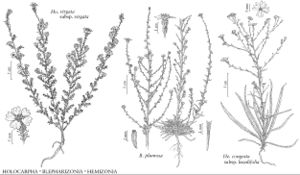Blepharizonia
Bull. Calif. Acad. Sci. 1: 279. 1885.
| Taxon | Illustrator ⠉ | |
|---|---|---|
 | Holocarpha virgata Blepharizonia plumosa Hemizonia congesta subsp. luzulifolia | Marjorie C. Leggitt Marjorie C. Leggitt Marjorie C. Leggitt |
Annuals, 10–180+ cm. Stems ± erect. Leaves basal and cauline; proximal opposite (forming winter–spring rosettes, often withering before flowering), most alternate; ± sessile; blades narrowly spatulate to linear or distal lanceolate, margins entire or serrate, faces hirsute to strigose, sericeous, pilose, or villous (distal leaves ± stipitate-glandular and/or bearing tack-glands as well). Heads radiate, borne singly or in ± racemiform-paniculiform, paniculiform, or spiciform arrays. Peduncular bracts: tack-glands usually 1+ at tips and on margins. Involucres campanulate or obconic to ± globose, 4–9+ mm diam. Phyllaries 5–13 in 1 series, lanceolate or oblanceolate (± navicular), herbaceous, each ± 1/2 investing subtended ray-floret proximally, abaxially canescent to hirsute or hispid to glabrate, usually bearing tack-glands as well. Receptacles flat, hirtellous, paleate (paleae falling, distinct, in 1 series, between rays and discs). Ray-florets 5–13, pistillate, fertile; corollas whitish (often nerved with red to purple abaxially, lobes ± parallel, 1/4–1/2 lengths of laminae). Disc-florets 5–35 (–60+), bisexual, fertile; corollas whitish to purplish, tubes shorter than the funnelform throats, lobes 5, lanceolate (anthers ± dark purple; styles glabrous proximal to branches). Cypselae ± terete or ± obcompressed, basal attachments central, faces (10-ribbed) ± sericeous, apices not beaked; pappi: rays 0, or coroniform; discs 0, or coroniform, or of 12–20+, (reddish-brown) subulate, ciliate to plumose scales. x = 14.
Discussion
Species 2 (2 in the flora).
Blepharizonia is evidently the sister group of Hemizonia, based on molecular phylogenetic data (S. Carlquist et al. 2003). Members of both genera have 2n = 28. Summer–fall-flowering populations of Hemizonia with white corollas may be confused with Blepharizonia unless the foliar glands and heads are closely examined. Distributions of Blepharizonia and Hemizonia abut in the eastern San Francisco Bay area, northwestern San Joaquin Valley, and South Coast Ranges; hybridization between the two genera has not been reported.
Selected References
Lower Taxa
Key
| 1 | Herbage gray-green, sparsely, if at all, stipitate-glandular, apart from scattered tack-glands; heads usually borne in ± spiciform-paniculiform arrays (branches often arched-ascending); involucres usually ± canescent (usually also with scattered tack-glands); pappi 1.5–3 mm | Blepharizonia plumosa |
| 1 | Herbage yellowish green, usually densely stipitate-glandular distally and with scattered to abundant tack-glands; heads borne singly or in ± open, racemiform-paniculiform arrays (branches ± virgate); involucres ± glabrate or hirsute to hispid (usually also with scattered toabundant tack-glands); pappi 0 or 0.1–1 mm | Blepharizonia laxa |